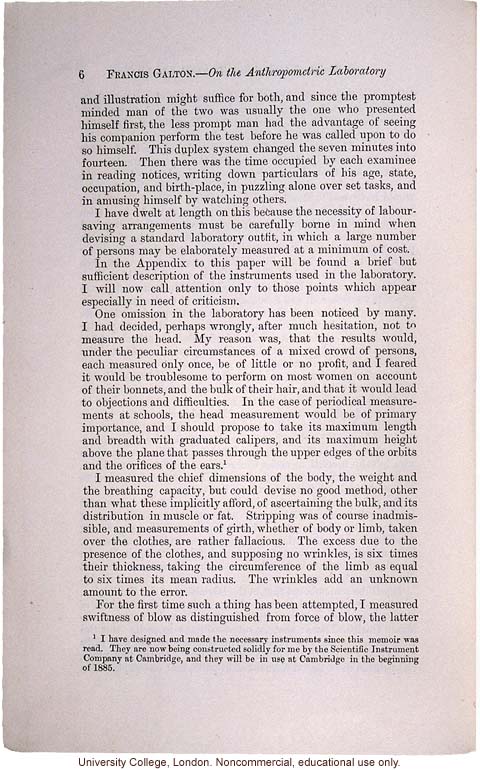6 Francis Galton. ---On the Anthropometric Laboratory
and illustration might suffice for both, and since the promptest minded man of the two was usually the one who presented himself first, the less prompt man had the advantage of seeing his companion perform the test before he was called upon to do so himself. This duplex system changed the seven minutes into fourteen. Then there was the time occupied by each examinee in reading notices, writing down particulars of his age, state, occupation, and birth-place, in puzzling alone over set tasks, and in amusing himself by watching others.
I have dwelt at length on this because the necessity of labour-saving arrangements must be carefully borne in mind when devising a standard laboratory outfit, in which a large number of persons may be elaborately measured at a minimum of cost.
In the Appendix to this paper will be found a brief but sufficient description of the instruments used in the laboratory. I will now call attention only to those points which appear especially in need of criticism.
One omission in the laboratory has been noticed by many. I had decided, perhaps wrongly, after much hesitation, not to measure the head. My reason was, that the results would, under the peculiar circumstances of a mixed crowd of person, each measured only once, be of little or no profit, and I feared it would be troublesome to perform on most women on account of their bonnets, and the bulk of their hair, and that it would lead to objections and difficulties. In the case of periodical measurements at schools, the head measurement would be of primary importance, and I should propose to take its maximum length and breadth with graduated calipers, and its maximum height above the plane that passes through the upper edges of the orbits and the orifices of the ears.[superior 1]
I measured the chief dimensions of the body, the weight and the breathing capacity, but could devise no good method other than what these implicitly afford, of ascertaining the bulk, and its distribution in muscle or fat. Stripping was of course inadmissible, and measurements of girth, whether of body or limb, taken over the clothes, are rather fallacious. The excess due to the presence of the clothes, and supposing no wrinkles, is six times their thickness, taking the circumference of the limb is equal to six times its mean radius. The wrinkles add an unknown amount to the error.
For the first time such a thing has been attempted, I measured swiftness of blow as distinguished from force of blow, the latter
[footnote superior 1]I have designed and made the necessary instruments since this memoir was read. They are now being constructed solidly for me by the Scientific Instrument Company at Cambridge, and they will be in use at Cambridge in the beginning of 1885.[end footnote]
[end]


